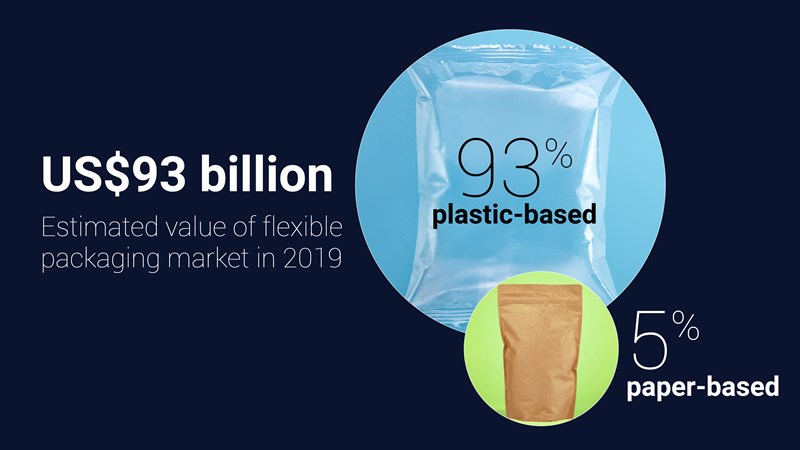Paper or plastic: what’s the most sustainable flexible packaging?
Consumer preferences are changing – but comparing green credentials is a complex issue
1 minute read
The use of plastics in flexible packaging has come under intense scrutiny in recent years. Paper is often lauded as a far more environmentally-friendly alternative – but how do the two materials really compare? And what is the most sustainable solution?
This article is an extract from the recent insight: Paper vs plastic: breaking down the debate in flexible packaging sustainability. Fill in the form for a preview or read on for a summary of key themes.
Plastic dominates the flexible packaging market
Paper has been used in flexible packaging for many applications, and for many years. It can be relatively low-cost, it’s highly processable and can be coated, used in laminations, and metallised.
However, by the early 2000s demand was declining. Plastic alternatives offered opportunities to downgauge, cut costs and improve shelf life. Global demand for polypropylene film (BOPP) has been growing by about 5% a year over the last decade, for example. Polyester film (BOPET) demand has grown at an average of 8%.
Our analysis puts the global market size for converter-supplied flexible packaging at around US$93 billion in 2019. Plastic-based packaging currently accounts for around 93% of total consumption. But the war on plastic could see that change.
Paper is down – but not out
After years of declining demand, paper-based flexible packaging is rising in popularity. Consumers are increasingly concerned about the undisputable problem of plastic waste. And paper is a renewable resource. It’s fully recyclable, biodegradable, and part of a circular approach when sourced from responsibly-managed forests.
As a result, many brands are investing in switching from plastic to paper-based packaging. For example, in 2019 Nestlé launched a snack bar in a recyclable paper wrapper, using high-speed production lines designed for plastic or laminate packaging.
Comparing green credentials isn’t straightforward
Public opinion is increasingly pro-paper. But identifying the most sustainable packaging choice for a product is a multi-layered issue. One of the biggest challenges is balancing market expectations on price and functional performance with recycling requirements and waste collection compatibility in different markets. Comparing green credentials just isn’t as straightforward as it might seem. For example:
- Paper is far more biodegradable than plastic and very easily recycled. But it often ends up in landfill, where its degradation rate slows – while it takes up more space than the same weight of plastic.
- Paper-based flexible packaging is often laminated with plastic or aluminium or coated with resin, becoming non-recyclable.
- Paper-only substrates would reduce the shelf-life of some products – resulting in increased waste.
What’s the impact of transportation costs and emissions? How does the production process compare? What are the cost implications of reducing plastic use? Visit the store to read this report in full or fill in the form for a preview.
What is the most sustainable solution?
Whether paper or plastic is the most sustainable substrate for flexible packaging largely depends on the application. In reality, the best approach is to reduce single-use packaging, regardless of the substrate.
Consumers are already engaging with the implications of packaging choices, but there’s work to be done. There’s still a need to shift perceptions around the ‘look and feel’ of packaging, reduce the emphasis on convenience, and change expectations of shelf-life and cost. The way forward for the flexible packaging industry is better recycling systems, more recyclable products, smaller amounts of substrate per package, and a bigger focus on a circular economy.
Read this report in full for more on:
- The environmental impact of paper and plastic-based flexible packaging
- The comparative costs of paper, polypropylene (PP) and polyethylene (PE) flexible packaging
- Innovation in more sustainable plastic-based solutions.
For a complimentary preview, which includes an overview of brands investing in plastic-to-paper transition solutions, fill in the form at the top of this page.







